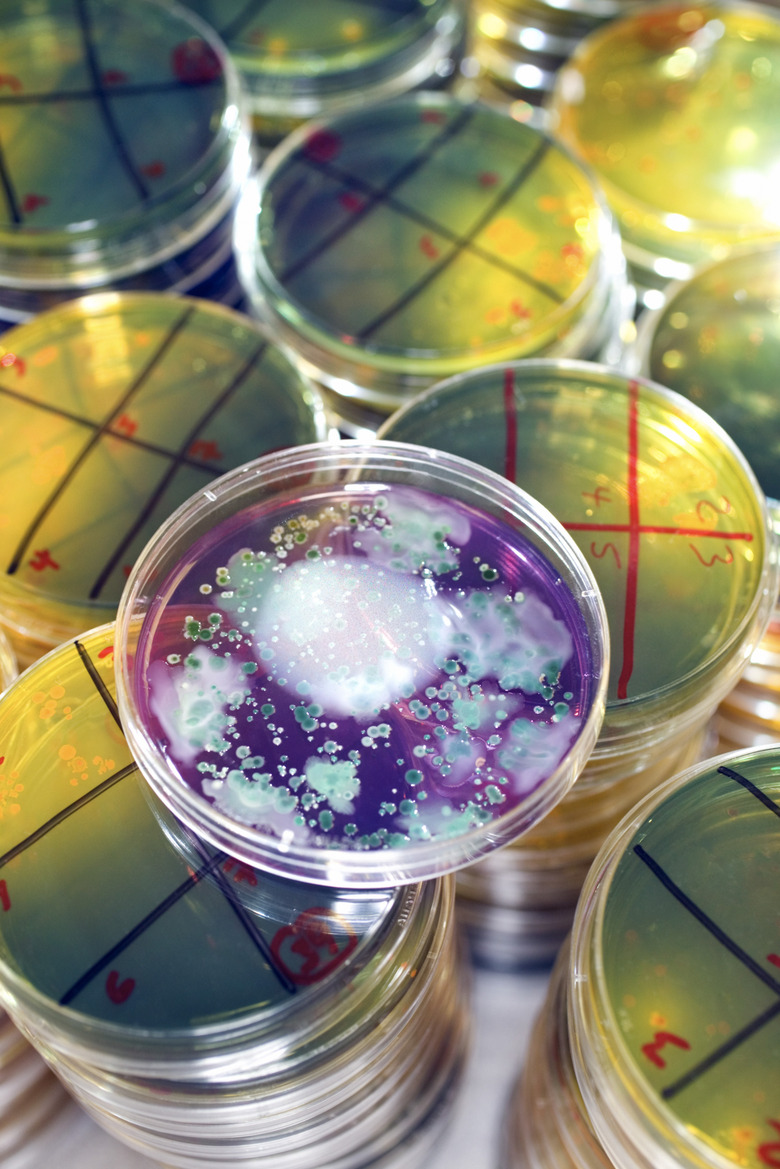How To Count Colonies In Microbiology
One of the classic ways to determine the concentration of microbes in a sample is to dilute the sample, grow the microbes on plates and count the colonies. The plated microbes grow from a colony forming unit consisting of one or more cells into a visible colony that can be seen and counted. Bacteria are the most common microbe to assess using plate counts. Colony counts are used to detect and count microbes in soil, water and food. Protocols for counting colonies emphasize an accurate and methodical approach.
Diluting Samples, Plating and Incubation
Diluting Samples, Plating and Incubation
If you simply smear a microbe sample on an agar plate, you'll see so many colony-forming units that the individual colonies will blend together, making them impossible to count. To solve this problem, mix the sample into a liquid medium, take a small amount of that mixture and further dilute it. Repeat this process six to 10 times. Spread the final dilution on an agar plate and incubate it for four to seven days before you count the colonies.
Manual Counting
Manual Counting
The primary trick in counting colonies is to count each colony dot once. One approach is to set the Petri dish on a grid background and count the colonies in each grid cell, moving in a methodical pattern through all of the cells. Marking counted colonies on the back of the Petri dish can also be a helpful approach. Generally, you will need to count at least three plates; only use plates containing 30 to 300 colonies to make robust inferences, suggests the Microbiology Network, a firm that provides consulting services to labs and manufacturers. Plates with colonies that are too numerous to count or with too few colonies need to be re-plated from a new dilution.
Automated Counting
Automated Counting
Human error adds to the time involved in counting colonies manually. To improve both accuracy and efficiency, place the Petri dish in an automated colony counting device. Automated colony counters take an image of the dish, separate out the colonies from the background and then use an algorithm to count the colonies on the plate. The algorithms can have difficulties differentiating colonies when two or more colonies are touching at the edges, so this is an area of ongoing software development.
Making Counting More Complicated
Making Counting More Complicated
The accuracy of calculating microbe density from colony counts does have some limitations. Colony-forming units can be a single cell, a chain of cells or a whole clump of cells. The assumption is that a colony represents one cell, so concentrations calculated from colony counts can be low. Different microbes need different growth conditions, and the colonies on the plate only represent those microbes that thrive on that growth media under those incubation conditions. In addition, colony-counting doesn't register dead cells, an important consideration when you need the concentration of cells in the original sample.
Cite This Article
MLA
Becker, Andrea. "How To Count Colonies In Microbiology" sciencing.com, https://www.sciencing.com/count-colonies-microbiology-17859/. 9 March 2018.
APA
Becker, Andrea. (2018, March 9). How To Count Colonies In Microbiology. sciencing.com. Retrieved from https://www.sciencing.com/count-colonies-microbiology-17859/
Chicago
Becker, Andrea. How To Count Colonies In Microbiology last modified August 30, 2022. https://www.sciencing.com/count-colonies-microbiology-17859/
